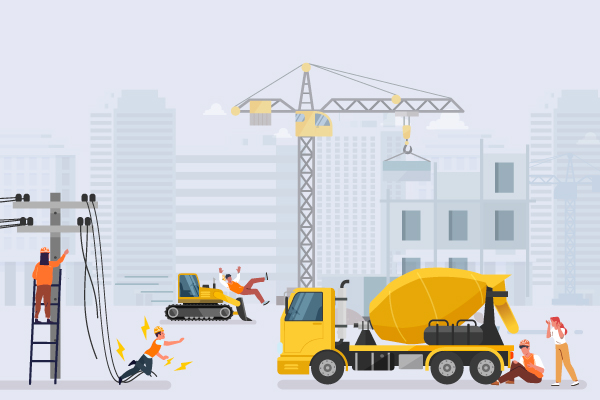
The construction industry is vital to infrastructure development worldwide, but it’s also one of the most dangerous sectors to work in. Among various hazards, the “Fatal Four” stands out as the leading causes of fatalities on construction sites.
The “Fatal Four” is comprised of falls, electrocutions, workers caught in or between objects and being struck by objects. In the United States alone, these safety incidents account for over 50% of construction worker deaths annually, tallying up to around 800 lives lost each year. These statistics are an urgent reminder to put into action safety measures to enhance workplace safety.
This article delves into the Fatal Four – what they are, why they’re so deadly and how construction companies can mitigate these risks to ensure worker safety. Through a multifaceted approach blending rigorous protocols, cutting-edge technologies and commitment from both workers and leadership, let’s strive to create a future where every worker returns home safely.
Understanding Fall Hazards
According to the Bureau of Labor Statistics, in 2021, nearly 1 in 5 workplace deaths occurred in the construction industry. Just over one-third of those construction deaths were due to falls, slips and trips. This makes falls the leading cause of death in the construction industry – yet they are preventable.
Defined broadly, fall hazards encompass any element within a workplace capable of destabilizing a worker and precipitating a potentially catastrophic descent. Whether it’s navigating uneven terrain, ascending a ladder or traversing slippery surfaces, the potential for a fall is pervasive given the amount of activity on a construction site.
Falls from Heights:
According to Occupational Safety and Health Administration (OSHA) standards, anyone working at a height of four feet or more is deemed to be at risk of a serious fall injury. The consequences of such falls can be catastrophic, leading to severe injuries, permanent disabilities or even fatalities.
To mitigate the risk of falls from heights, employers are legally obligated to implement robust safety measures. OSHA mandates that guardrails, safety net systems and full-body harnesses be utilized whenever employees are working from a height of six feet or above. These safeguards serve as critical barriers between workers and the precipice, offering a vital lifeline in an unforeseen stumble or misstep.
Falls on the Same Level:
Falls on the same level are a subtler yet equally perilous threat to construction workers. These incidents can occur due to various factors, including slippery surfaces, cluttered pathways, poor illumination, blind corners or uneven terrain. Despite seeming commonplace and ordinary, falls on the same level can result in serious injuries, ranging from sprains and strains to fractures and concussions.
Mitigating the risk of falls on the same level requires a comprehensive approach that addresses both environmental hazards and human factors. Employers must prioritize regular maintenance of walking and working surfaces, ensuring that they remain free from debris, spills or other obstructions. Additionally, promoting awareness and proper footwear among workers can help minimize the risk of slips, trips and falls on construction sites.

Navigating Electrocution Hazards
Electrocution hazards occur in various ways, ranging from direct contact with live electrical equipment to inadvertent encounters with overhead power lines. Construction workers regularly navigate a maze of electrical challenges, including faulty wiring, malfunctioning equipment and inadequate safety precautions.
While electrocutions are less frequent than other Fatal Four hazards, they pose a disproportionately high risk of severe injuries and fatalities. In 2020, there were 56 deaths of construction workers, making up 44% of the workers who died from electrical exposure. These hazards are completely preventable but continue to be a leading cause of fatalities.
Mitigating Electrical Hazards:
Many of the workers who experienced fatal electrical injuries were not trained electrical specialists. Training in safety procedures is one of the most effective ways to mitigate safety hazards. In addition, it’s important to offer safety training and related materials in the native language of the workers. For example, Latinos make up 30% of the construction workforce in the US, but 40% of those killed by electrocutions.
A multifaceted approach is needed to reduce or eliminate electrocutions, but in general, it is important to control contact with electrical voltages and the currents they can cause. Safe work practices such as using caution near energized lines, de-energizing equipment before inspection and repair, properly maintaining tools and equipment and using appropriate PPE are all important.
More specific steps include:
- Complying with and following all OSHA and NFPA electrical safety standards.
- Training workers in electrical safety.
- Locating overhead and underground power lines to avoid accidental contact.
- Contacting utility companies to de-energize power lines.
- Maintaining a safe distance of ten feet or more from power lines.
- Using lock-out/tag-out practices.
- Ensuring all electrical equipment is properly grounded or double insulated.
- Inspecting and checking tools prior to use.
- Disconnecting the plug on any power tool or machinery before inspecting or repairing.
- Keeping metal objects away from live electrical circuits/parts.

Workers Caught In or Between Objects
Construction sites are dynamic environments where workers face numerous risks daily. Among these dangers, caught-in/between incidents constitute a significant threat to worker safety. These incidents involve workers becoming trapped, crushed or pinned between heavy machinery, collapsing structures or materials, leading to severe injuries or even fatalities.
In 2021, approximately 5% of construction worker fatalities resulted from incidents where employees became trapped in or between machinery, equipment, tools or trenches. This includes situations where workers were caught between moving or rotating equipment and collapsing structures or materials. Many of these injuries occur due to operating unguarded or inadequately safeguarded machinery. Various machines, including power presses, conveyors, milling machines and more, pose significant risks to workers.
To address these hazards, employers must implement robust safety protocols and machine safeguards. These include:
- Hard guards: Physical barriers preventing contact with hazardous moving parts.
- Safeguarding devices: Limiting or preventing accidental access to hazards, such as two-handed controls, gates or presence-sensing devices.
- Automated feeding and ejection mechanisms: Reducing the operator’s exposure to machine operation.
- Electronic presence-sensing devices: Stopping the machine in the presence of a person’s body, hands or fingers, including safety light curtains, safety mats and safety area laser scanners.
- Machine location or distance: Removing hazards from the operator’s work area.
- Miscellaneous aids: Shields, protective guide tools and awareness barriers to enhance safety.
In addition to machinery hazards, trenching and excavation present serious risks to workers. Cave-ins in particular pose a significant threat and are more likely to result in fatalities compared to other excavation-related incidents. Employers must ensure proper protections are in place, such as shoring, bracing or maintaining a safe distance from nearby structures.
Precautions to protect against falling loads and ensure the stability of nearby structures are also crucial. Warning systems on mobile equipment and providing clear communication between operators and ground personnel further enhance safety measures.

Struck By Hazards
Struck-by incidents represent the second leading cause of death among construction workers and the number one cause of nonfatal injuries in the industry. They encompass a range of scenarios where workers are at risk of being forcibly impacted by objects.
There are 4 main types:
- Flying Object: Objects propelled through the air.
- Falling Object: Objects that drop from above.
- Swinging Object: Objects in motion that can strike workers.
- Rolling Object: Objects that roll or move horizontally.
Example scenarios of struck-by hazards include:
- A moving vehicle hitting a worker.
- Flying particles during an abrasive or cutting process.
- An improperly controlled power tool.
- A load of materials shifting mid-transport.
- Materials falling due to rigging failure.
- Tools or materials dropped by workers on higher levels.
- Collapsing structures due to inadequate bracing or shoring.
Preventive Measures
To mitigate struck-by hazards, it’s essential for workers to adhere to safety regulations outlined by OSHA and their employers. Wearing appropriate PPE, such as hard hats, safety glasses and high-visibility vests can greatly reduce the risk of injury in a struck-by incident.
Employers should implement barriers or warning signs to delineate hazardous areas and prevent unauthorized access. Proper training in hazard identification and prevention is also crucial for all workers to recognize potential struck-by hazards and take appropriate precautions.
Furthermore, analyzing environmental factors such as wind direction before conducting mechanical lifts and ensuring proper stacking and securing of materials can help minimize the risk of falling or flying objects.
Relevant Regulations and Standards
Ensuring regulatory compliance and adhering to legal obligations isn’t just about avoiding fines or penalties; it’s about safeguarding the lives and well-being of every worker on the job site. Regulations and standards established by organizations like the OSHA, which aim to mitigate the most common and deadly hazards in construction, should be the baseline standard of health and safety.
OSHA’s regulations provide a comprehensive framework for ensuring workplace safety in the construction sector. Specifically, the Construction Fatal Four represent the leading causes of fatalities in the industry, accounting for a significant portion of all construction-related deaths each year. These regulations mandate specific safety protocols and procedures aimed at mitigating the risks associated with these hazards.
For instance, fall protection standards require guardrails, safety nets or personal fall arrest systems when working at heights above six feet. Similarly, regulations governing electrical safety mandate proper grounding and insulation of electrical equipment to prevent electrocution incidents. Protocols for preventing struck-by incidents emphasize the importance of maintaining clear work areas and using signage to alert workers to potential hazards.
The legal ramifications of non-compliance with OSHA regulations can be severe, encompassing fines, penalties and even criminal charges in cases of egregious negligence. Beyond financial liabilities, employers may also face civil lawsuits filed by injured workers or their families seeking compensation for damages resulting from workplace accidents. Moreover, instances of non-compliance can tarnish a company’s reputation and lead to loss of business opportunities.
Going Beyond Compliance: Enhancing Safety and Productivity
While compliance with OSHA regulations is essential, forward-thinking construction companies recognize that prioritizing safety extends beyond mere adherence to minimum standards. By proactively implementing comprehensive safety programs and fostering a culture of safety among employees, organizations can significantly reduce the risk of accidents and injuries. Moreover, investing in advanced safety technologies and training initiatives not only enhances worker protection but also yields tangible benefits in terms of operational efficiency and productivity.
Research has consistently shown that organizations committed to safety outperform their peers in various metrics, including employee satisfaction, retention rates and overall productivity. By going beyond compliance and embracing a holistic approach to safety management, construction companies can create safer work environments, foster greater employee engagement and ultimately achieve sustainable success in a highly competitive industry.
Digital solutions like Intelex Construction Safety Software can further enhance safety management efforts by streamlining processes, facilitating proactive risk assessment and promoting continuous improvement in safety protocols. Together, through proactive measures and innovative tools, we can create safer work environments and build a brighter future for the construction industry.

